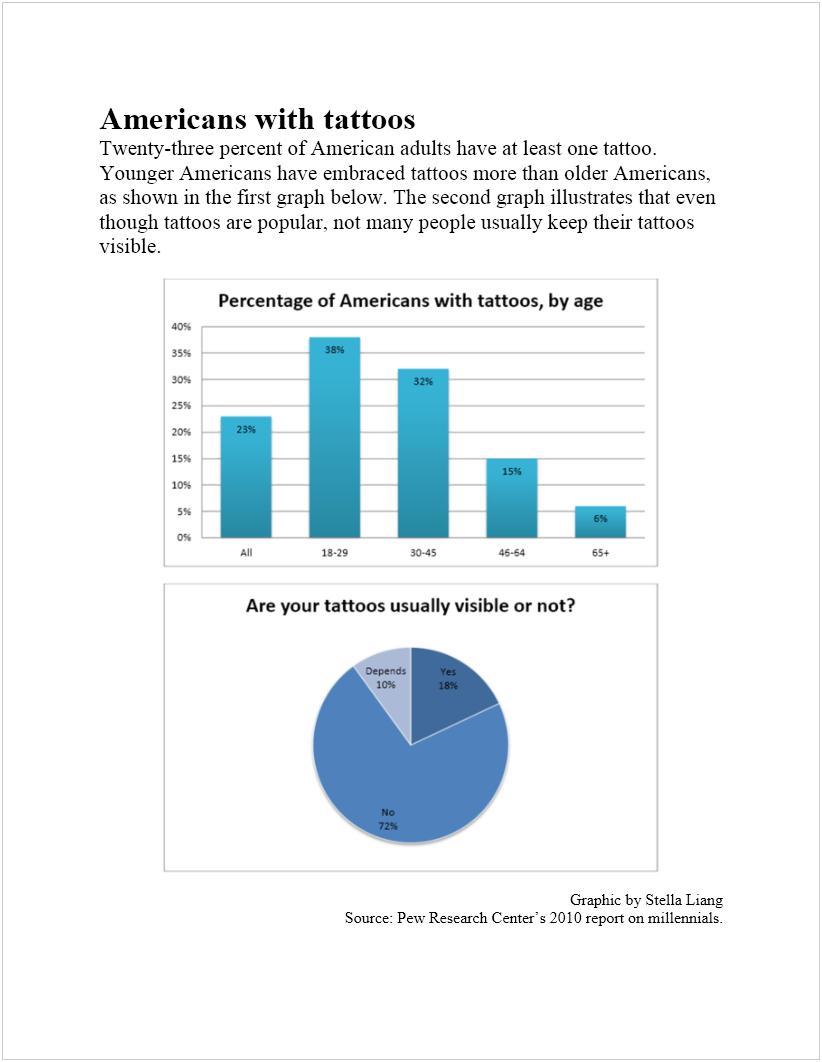What follows is a three-part package about tattoos in the workplace and how to cover them up, hopefully not while losing style points, if necessary. The first part is a story about when tattoos should be hidden at work. What follows is a photo gallery of professional outfits and tips on how to cover tattoos with clothes and accessories. The final part is a graphic illustrating the prevalence of tattoos and whether or not they are usually visible.
Tattoos in the workplace
By: Stella Liang
Walking in to film the Lawrence city commission meeting, University of Kansas senior Mark Sidener is careful about what he wears. The soon-to-be college graduate wears a long-sleeved shirt and pants to make sure his three tattoos, one on his calf, one on his bicep and one on his chest, are fully covered up.
Sidener said that in the film industry, while tattoos are common and used as a way for the artists to express themselves, certain job situations call for hidden tattoos.
Sidener is one of the 23 percent of American adults, and one of the 38 percent of the adults ages 19-29, who have at least one tattoo, according to a 2010 Pew research report on the millennial generation (More data is shown in the graphic below). Tattoos are becoming more popular, but employees should still be cautious of having visible tattoos in the workplace.
Craig Warlick, a graduate assistant at the University Career Center at KU, said the most important thing to consider when deciding whether or not to cover up tattoos in the workplace is knowing the culture of the company. For example, he said tech companies tend to be more liberal and acceptable of tattoos.
“Some of those places you can wear shorts and flip-flops to work, and if you have tats coming up your legs, that’s totally acceptable as part of that culture,” Warlick said. “Some other places may have more of a conservative environment, and so if you do have those tattoos, it’s best to hide them if at all possible.
According to a study done by careerbuilder.com where about 2,800 employers were surveyed, 31 percent cited visible tattoos as a reason to not give a promotion. Most companies do not have a written tattoo policy. For example, Bank of America spokesman Ferris Morrison, said in an interview with Forbes magazine, said there are not written rules or policies. Some organizations do have explicit policies; the New York State Police forbids any visible tattoos, according to its website.
Even if the culture is accepting of tattoos, content is also important. Tattoos with expletives and inappropriate images are seldom acceptable, Warlick said.
Location of a tattoo has an impact on how or if a tattoo can be hidden. Tattoos on the back or chest may never be visible under professional attire, while tattoos on the neck or hand might be difficult to ever cover. Warlick said he suggests before getting a tattoo to think about whether or not the tattoo can be covered if necessary.
Kansas State sophomore Christine Lenz decided to get her tattoo in a location, on her ankle, which would make it easy to hide in the future.
Members of the millennial generation, like Lenz, typically find tattoos more acceptable, as evidenced by the high percentage of them having at least one tattoo. Tattoos come with stigmas and also those with tattoos have certain values. KU senior Brandon Surgnier said he will not cover up his tattoos, which are on his forearm and upper-back, for anyone. He said the quality of his work doesn’t change because he has a couple of tattoos.
“There are lots of opportunities in the world,” Surgnier said. “Unless something happens when it becomes a problem, I won’t cover it up.”
However; it might be difficult finding a job that has the same values as the millennials do.
“A lot of times you have to gain that experience and transition over to places where they can identify with your values, Warlick said. “My first thing would be always to say be mindful of those tattoos especially in the beginning.”
Tattoos can present a certain image. Even if it’s not negative , Warlick said he warns against being judged or branded prematurely.
“It’s a part of branding yourself and creating this professional image,” Warlick said. “The majority of the literature would state that you should try to brand yourself based upon the quality you bring to work and the qualities of your personality, not so much the ink that’s on your body.”
###
Photo Gallery: What to wear to hide tattoos
Sophomores Alysha Lieurance and Sonny Tallavajhala model professional clothes that will cover most tattoos. Each picture also includes tips on what tattoo-hiding clothes and accessories, like cardigans and large bracelets, to wear. Click on the picture to enlarge. Photos are by Stella Liang. Craig Warlick, graduate assistant at the University Career Center, contributed ideas.
Americans with tattoos
The graphic below illustrates the prevalence of tattoos in the United States, and whether or not they are in visible places. The millennial generation has the highest percentage of adults with tattoos. Click on the graphic to enlarge.







